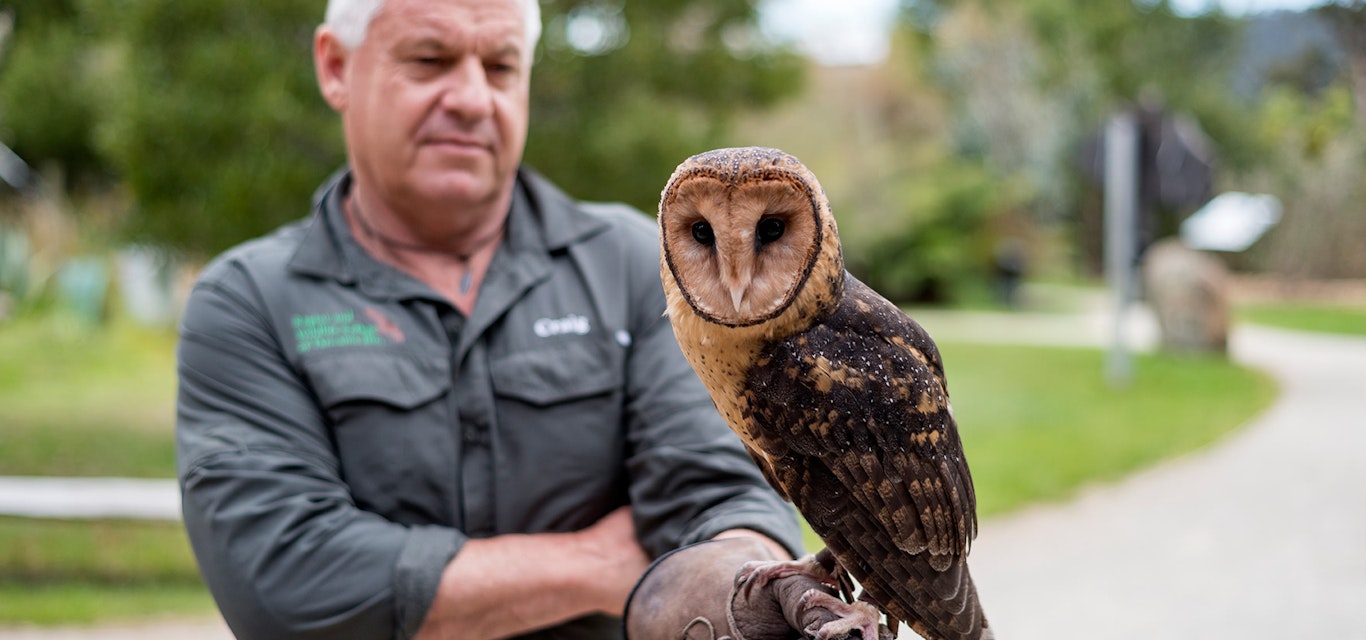A mile in the shoes of a raptor rescuer
'Raptor Man' Craig Webb has always had a special bond with birds and animals, and intertwined his passion and day job.
It’s mid-winter as Craig Webb wades into frigid waters 100 metres offshore to rescue an injured ‘wedgie’. Back at his wildlife centre Raptor Refuge, wet and freezing, he jumps in the shower fully clothed with the endangered Tasmanian wedge-tailed eagle to warm them both up.
Craig does whatever it takes to rescue injured birds of prey affected by habitat loss, poisoning, shooting, collisions and more, earning him the nickname ‘Raptor Man’.
Raptor Refuge, a not-for-profit dedicated to rehabilitation and release, resides discreet among native bushland and landscaped gardens in Kettering, 30 minutes south of Hobart.
Craig has always had an affinity with animals. “They seem to be attracted to me, whether its finding bats strung up on fences in my travels or fairy prions landing exhausted at my feet on the Spirit of Tasmania. It was like destiny.”
After five years spent working and soaking up knowledge at a veterinary clinic in the Kimberley, Craig returned to Tasmania in 1997 and purchased the land at Kettering. “I got licenced to look after kangaroos and wallabies and built enclosures on my 20-acre property. A few birds came in so I knocked up some makeshift aviaries. The turning point was when a sea eagle came in. I thought, ‘Wow, this is a serious bird. I need to make a really big aviary.’”
Credit: Luke O'Brien Photography
Credit: Raptor Rescue
Craig was working in the aquaculture industry at the time and ingeniously made an aviary out of an old salmon farm net, despite some naysayers. “I’m a bit of a stubborn bloke. If I have a good idea and think it’ll work, I’ll run with it. I basically strung the net up between poles, giving these big birds more room to fly and get fit prior to release. It’s snowballed since then.”
The centre now has a 16,500-cubic metre aviary made in Croatia, an 80-metre donut-shaped flight tunnel and an education centre with a small hospital facility.
But Craig dreams big. To all this, he wants to add an X-ray machine, have vets onsite, and invite experts from Abu Dhabi and Dubai to share their knowledge of treating falcons.
No two days are the same for the straight-talking Craig. Pragmatic and tenacious, he arranges post-mortems, collects roadkill, manages staff and volunteers, liaises with an advisory board and lobbies industry for bird safety. He’s currently working with TasNetworks on installing inexpensive measures such as pole-top perches to reduce raptor electrocutions.
Credit: Luke O'Brien Photography
He also offers guided tours which, along with calendar sales, raises money, as the refuge doesn’t receive government funding. Recuperating raptors are off-limits to visitors, but birds that can no longer survive in the wild are their ambassadors, including eagles, owls, hawks and falcons.
There are boobook owls whose asymmetrical ears enhance hunting, masked owls whose ultraviolet vision enables them to see their prey’s urine trails, and brown falcons whose double-chest feathers protect against snake bites.
Once you’ve looked into the beguiling face of a Tasmanian masked owl, you’ll likely become as passionate as Raptor Man.
How can you help?
- Help birds by removing roadkill to reduce collisions and trapping rodents to prevent secondary poisoning
- Report injured or dead birds of prey to Craig's Raptor Rescue Hotline 1800 RAPTOR
- Visit the Raptor Rescue website and book in for a tour
